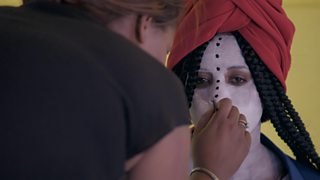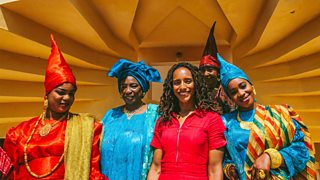Producer/Director Alex Brisland on creating African Renaissance: When Art Meets Power
'African Renaissance: When Art Meets Power' began life in late 2018 and became a big part of my life for more than a year. I developed the project while working for ClearStory, and was afforded the privileged opportunity to direct two of the three films, and travel out to Ethiopia, Senegal, and Kenya.


The interconnectedness between Britain and Africa is something I found wherever we went
These three countries act as case-studies for Afua Hirsch’s personal journey into African history. We see her in an exciting set of encounters with extraordinary visual art and literature, music and fashion, approaching African art in the broadest and truest sense possible, with modern cinema alongside traditional dance. In the process, Afua offers a bold retelling of the continent’s past, and a strong take on where it’s headed.
To tell a comprehensive story of Africa through just three countries is of course futile. There is no single African story to tell. With hundreds of ethnicities and a couple of thousand languages, Africa is the most culturally diverse place on the planet. So, though these countries only scratch at the surface of the cultural variety to be found across the continent, they do I hope represent a teasing introduction to what’s there. Ethiopia, Senegal, and Kenya, have entirely distinct histories, cultures, peoples, and languages. And the three films are, in an exciting way, completely different as a result.
The Ethiopian film traces a proud three thousand year history that takes in Christianity, Emperors and communists. We find out how this independent country became a beacon for the African diaspora. In Senegal, we explore how an Islamic and Francophone West African country has achieved a cultural power far beyond its small size. The dynamic film, fashion and hip hop scenes there today have fed off historic power struggles between ancient empires and against French colonisers. And finally Kenya, a young country created barely a century ago. It’s a place full of contrasts, of stunning landscapes alongside the madness of urban Nairobi. The story we chart here is how Kenya began life as idealised vision in the minds of British colonists, but how art and culture became a key tool in the reclaiming of identity after independence.
In each film, we look back at the past, but we also give a strong sense of what’s happening today. I was struck by the excitement all the contributors we met had for the direction their country and their continent was headed. Africa has young and fast-growing populations (with an average age below 20), with economies and cultures that are evolving at hurtling speed. It was important to all of us involved that Africa was not presented in a cliched way as stuck in the past. Despite all its challenges, it’s a continent of optimism and energy. We wanted to make it clear that art and culture is not an adjunct to this story, but is in fact driving and reflecting the change that’s happening.
Some of my personal highlights from the trips include interviewing several fascinating modern artists who embody this story. Photographer Aida Muluneh in Ethiopia, painter Michael Soi in Kenya, hip hop star Dj Awadi and fashion designer Nunu in Senegal, all spring to mind. All of their work riffs on the past. But, their art remains rooted in today’s questions and is unencumbered by the confines of history, drawing their inspiration from across the world as much as their own identity and tradition. Together, they form part of a powerful new wave of African artists, shaking things up and shifting the story.
We tried as much as possible to be led by what these contributors told us about their country, rather than imposing a view from the outside. We were also guided by the brilliant local producers we worked with in each country, Zablon in Ethiopia, Adams in Senegal, Guy in Kenya, without whom a series like this wouldn’t be possible at all. From the many conversations prior to filming, to the fruitful discussions when on location, we tried to leave space for these insights to be worked in to the series as we were making it. We wanted the final series to reflect a local take on the art and culture of each country.
Having finished on this series last year, it’s hard not to reflect now, in the shadow of what 2020 has become. I hope and believe the series can inform some of the conversations happening across Britain in the wake of the BLM movement, dealing as it does with slavery and race, colonialism and Empire, telling the story as much as possible from an African perspective. It is a history, of course, in which Britain reappears throughout, in many uncomfortable ways. In Kenya, we filmed at a detention camp for suspected Mau Mau fighters, built in the 1950s. Not to be ignored is that the Mau Mau story is as much a part of British history as it is Kenyan. And recent history at that.
The interconnectedness between Britain and Africa is something I found wherever we went. From the British railway that strides across Kenya to this day, to the Senegalese slave island of Goree that was used by the British before the French, to the story of Sylvia Pankhurst the Suffragette who befriended Ethiopian Emperor Haile Selassie. It’s a reminder that so many global forces and events – WWI and WWII, the spread of Christianity and Islam, to the rise of China and Covid-19 today – bind the history and future of Britain with that of the African continent.
This series is just one personal take on the art and culture of three African countries. It’s by no means the whole story. But, I hope it intrigues, excites, and transports you for an hour or so to some unfamiliar places, and challenges with some new ideas. For me, it was an incredible experience to work on this series, eye-opening, profound and fun in equal measure. I hope it encourages others to reassess their view of African history and culture, to explore it fully for themselves.
African Renaissance: When Art Meets Power starts Monday 17th August at 9pm on �鶹������ҳ��� Four and �鶹������ҳ��� iPlayer.
